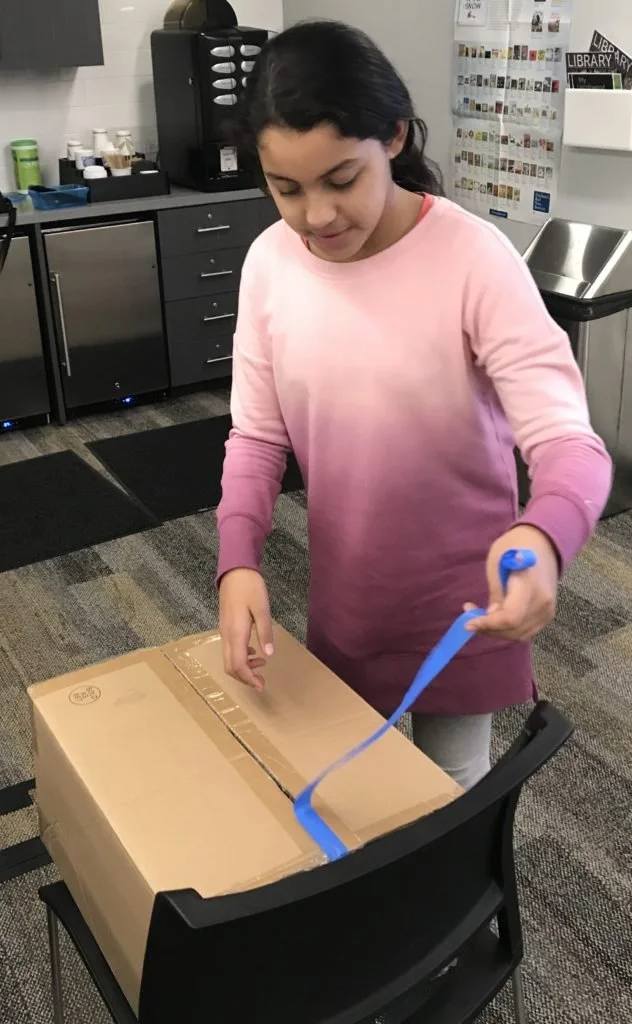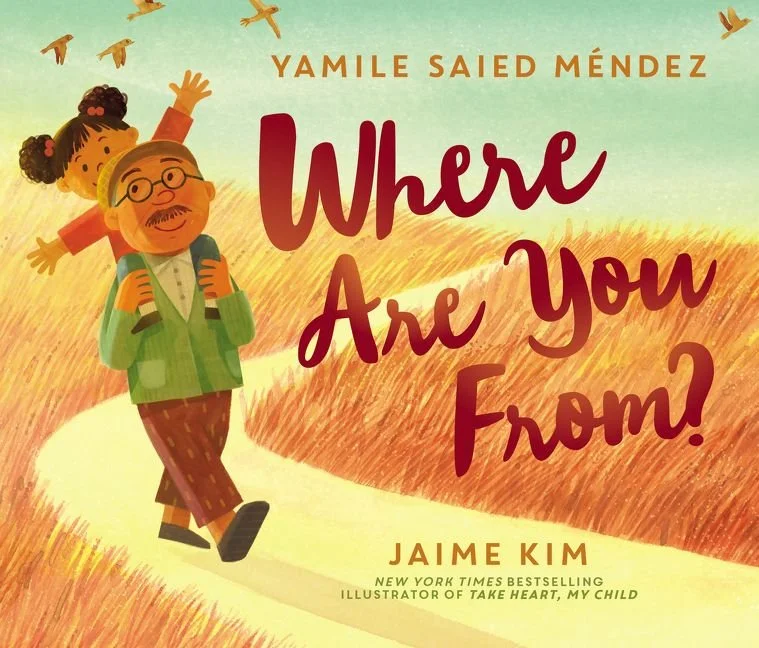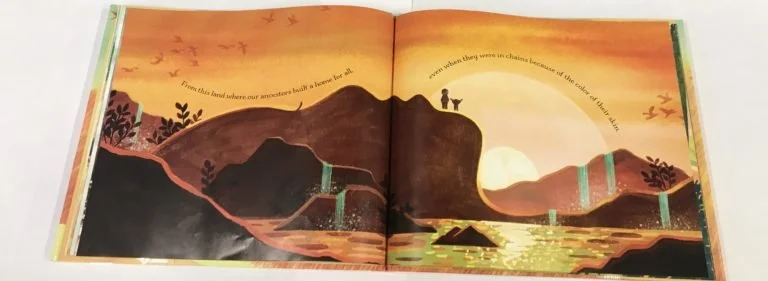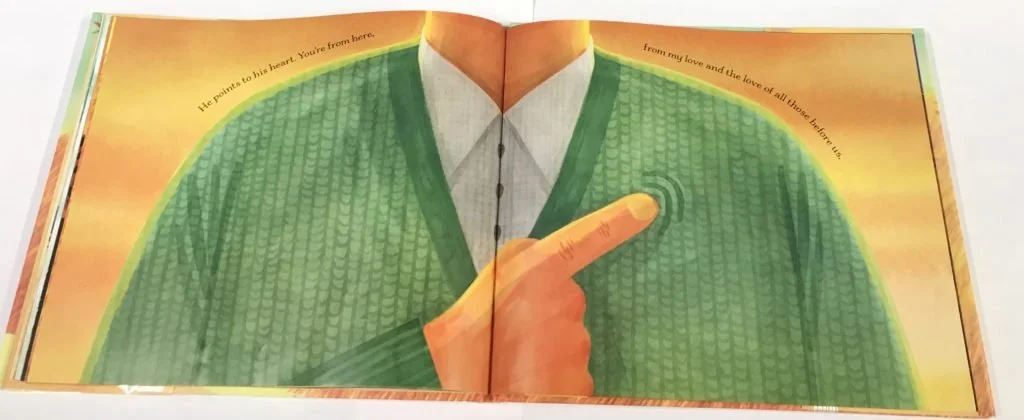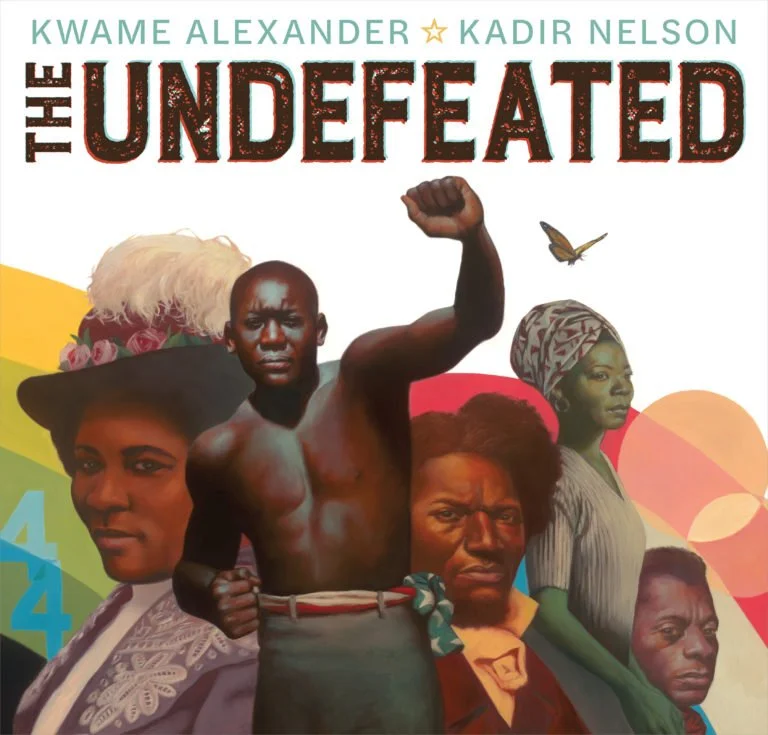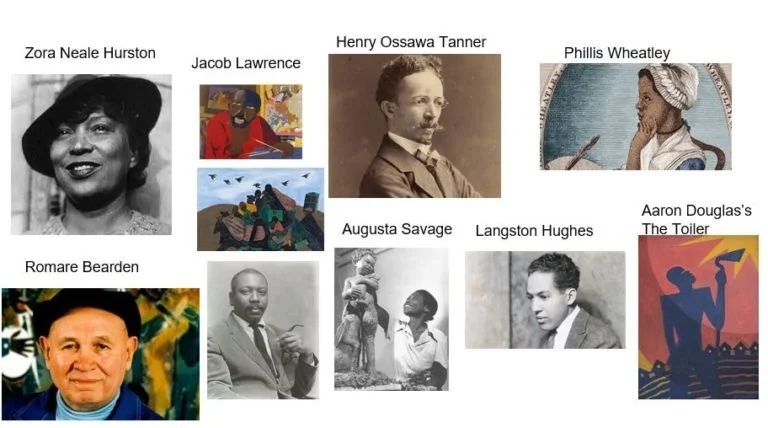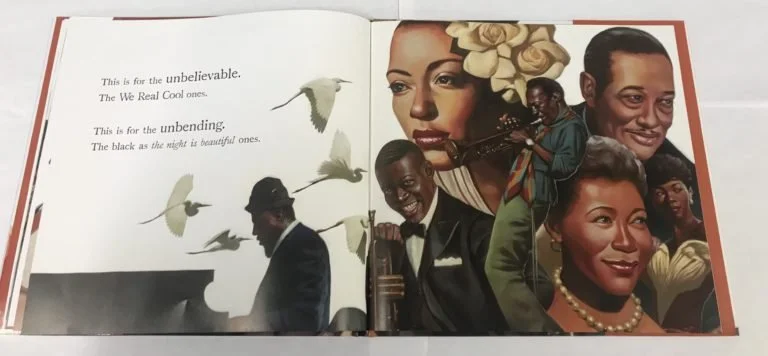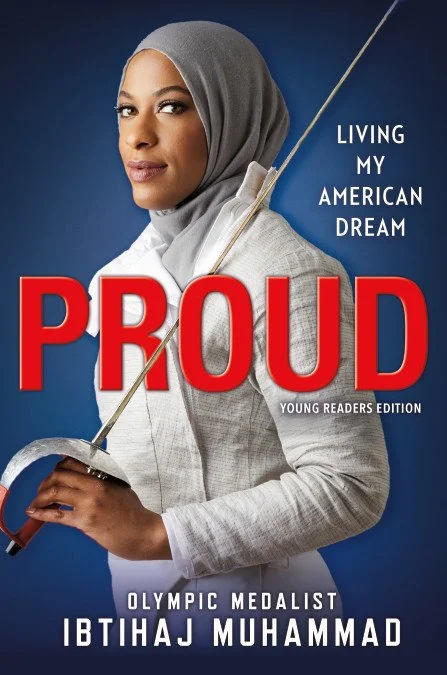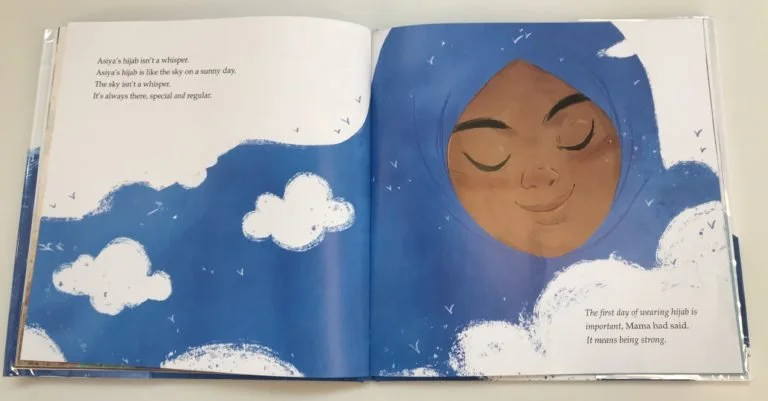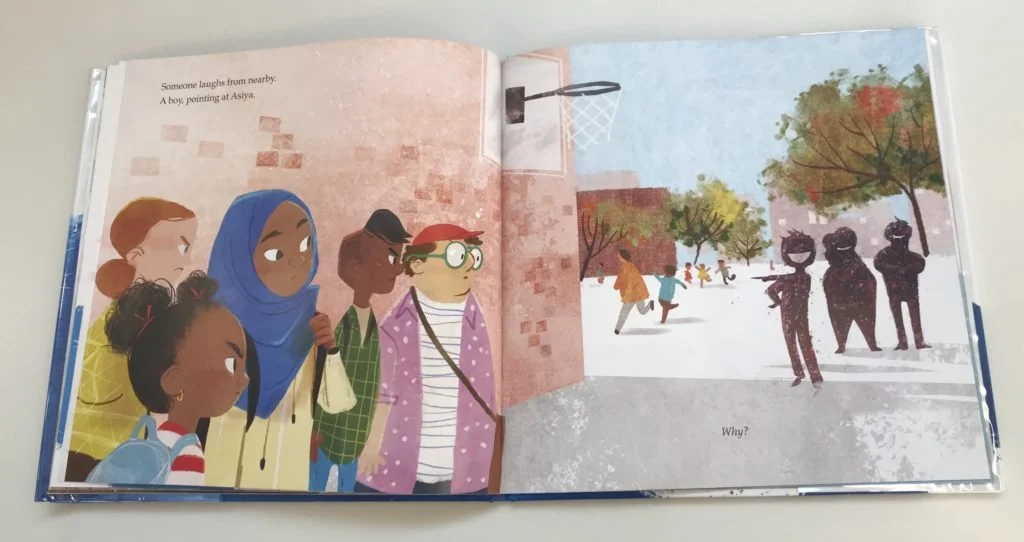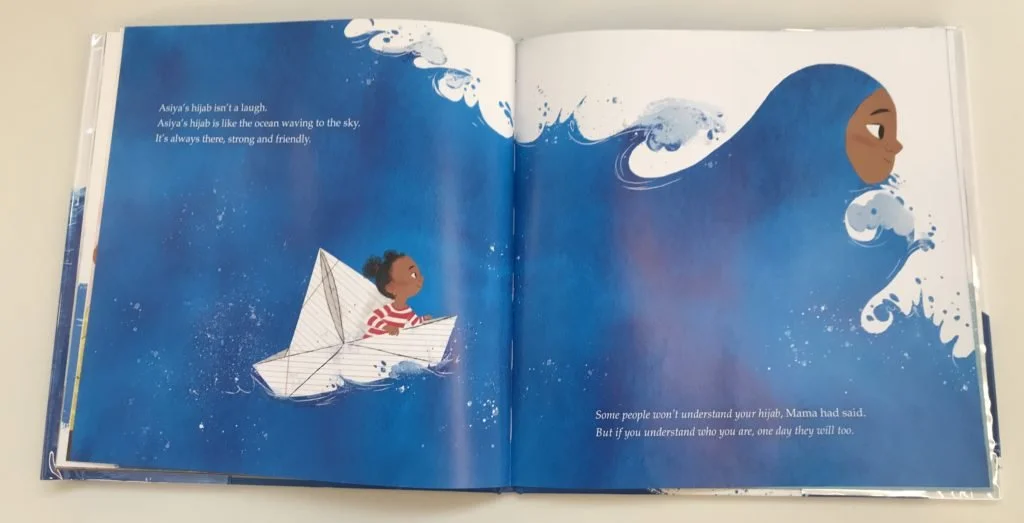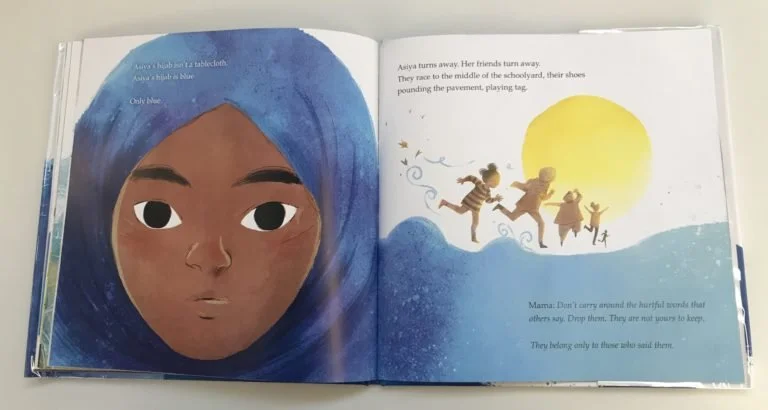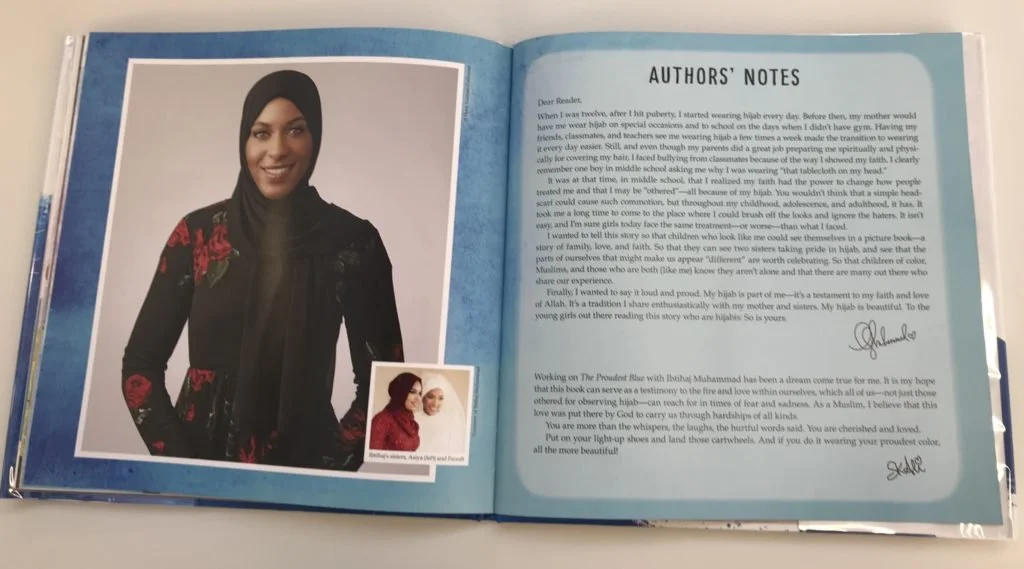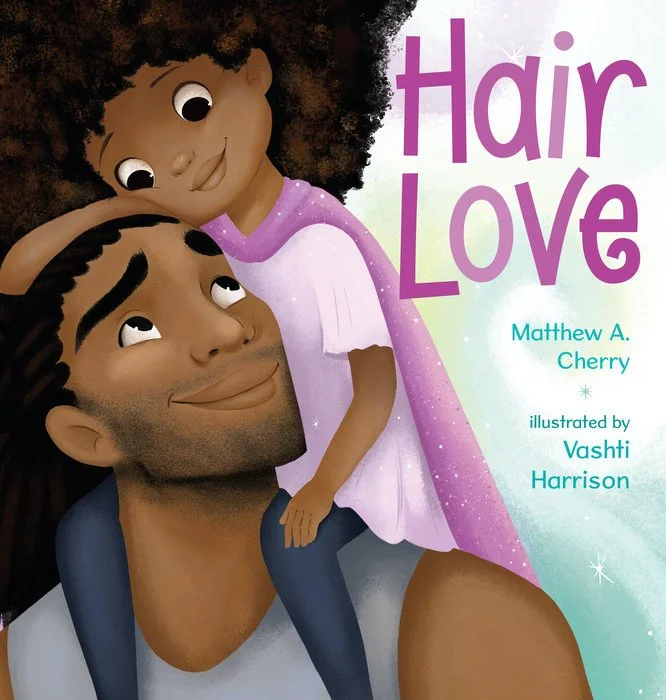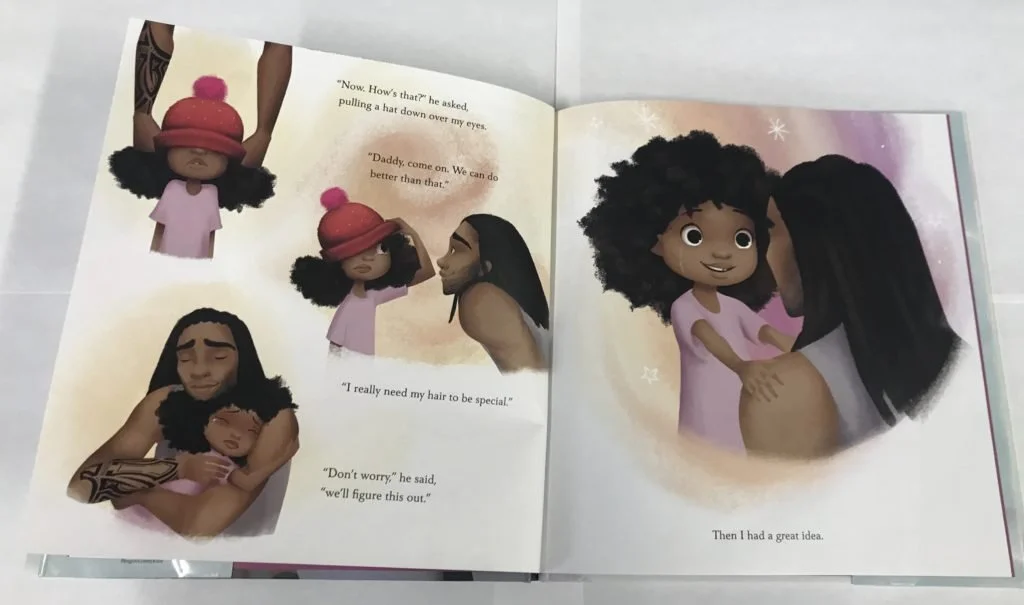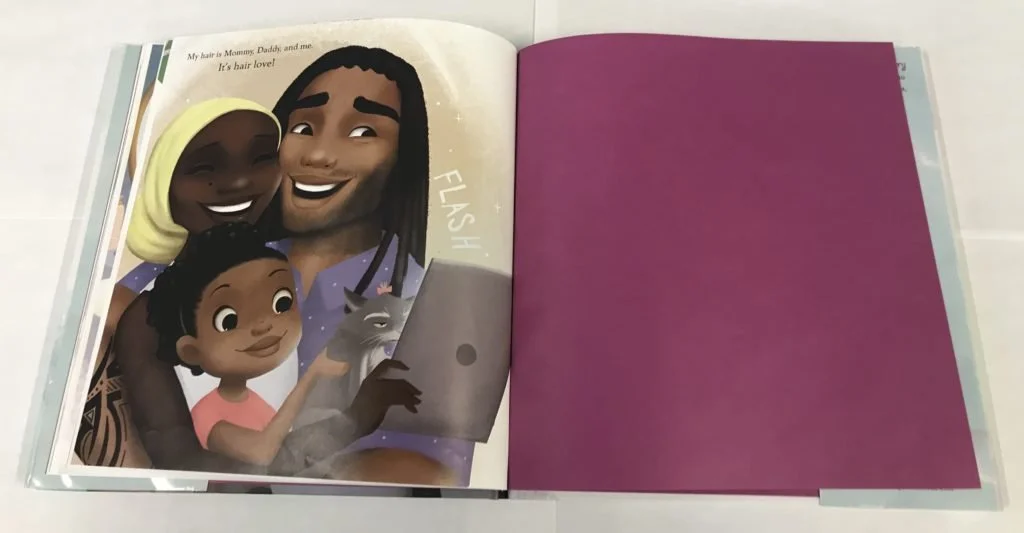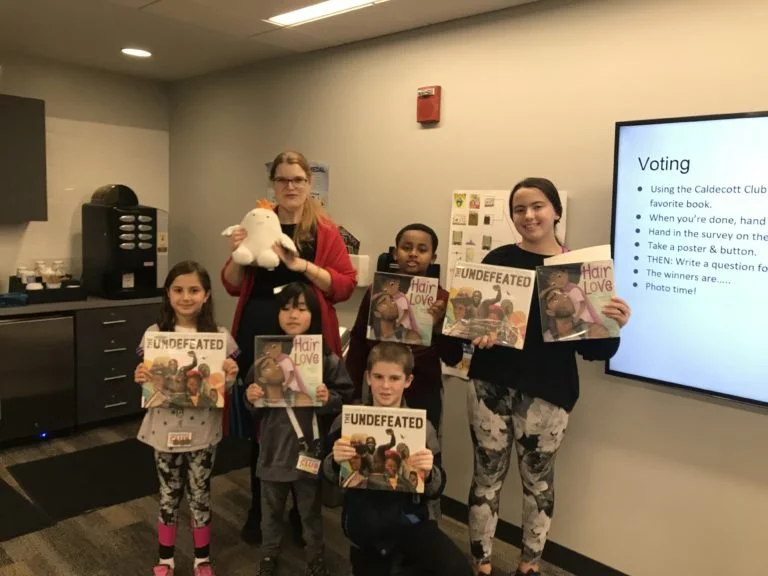Caldecott Club 2019: Session 5
Posted first on December 11th, 2019
We had our 5th session on Thursday, December 5th and selected our final 2 books to send to our Voting Party in January. To refresh your memory, the Caldecott Award is the award for the most distinguished American picture book for children, given out each year by the Association for Library Service to Children. We began our program by having Ya. open our final box of books for us to explore.
The books we discussed in session 5 were:
Where Are You From? by Yamile Saied Méndez, illustrated by Jamie Kim
The Undefeated by Kwame Alexander, illustrated by Kadir Nelson
The Proudest Blue by Ibtihaj Muhammad with S. K. Ali, illustrated by Hatem Aly
Hair Love by Matthew A. Cherry, illustrated by Vashti Harrison
Here’s the necessary spoiler alert for all of these picture books.
Picture Walk
The irony of hosting a program series is once you figure out the things that work and don’t, the program is almost over. Our latest Caldecott Club session was the best yet, I think, with our group sitting around a table by the screen with clearer images of the books. Everyone was very welcoming of our new friend, Al., who joined us at this session. I remain grateful that Ms. Gaby joined us again during this session, which was a huge help! She ensures that everything runs smoothly. Thank you, Ms. Gaby!!
I began our session by playing a video made by club members, A. & K., with their friend, Ab., revealing the titles we were going to read. How cool is it that some of the authors mentioned actually reposted this video on Instagram? One of our friends also told me that their teacher played their video in class! We’re famous!
I began our journey by asking our group a pre-reading question. Our theme was pride, so I asked them to think about and write down their ideas: What’s something special about you that you’re proud of? Something special about your family, your culture, your history? Some answers included skills like dancing or singing, another kid wrote that she was proud of her different cultures and that she’s a lefty. Framing our conversation with these ideas in mind helped us look at the books thematically.
Where Are You From? by Yamile Saied Méndez, illustrated by Jamie Kim
I began our discussion by asking the group, “when you see this title, “Where Are You From?” what does it remind you of or make you feel? Y. shared that it’s asking where her family members are from, where they live. C.. asserted, “mind your own business,” which led us to discuss how this question can be asked in mean, nosy way. S. said it reminded her of her grandmother’s house and visiting her there. A. said “I think about my family.” A. later added, “sometimes when people ask that, people feel uncomfortable.. Or if they say it, maybe there’s something going on there, and they don’t like the place [the other people are from].” This brilliant insight helped us think critically about the often double-meaning embedded within this question that is used to isolate or discriminate against people.
I shared that Yamile Saied Méndez is an Argentine-American and her husband is Peurto Rican. In a TeachingBooks interview, Yamile said, “My name is Yamile Daniela Saied Mendez. Yamile is an Arabic name, and because I’m Argentine, I pronounce it with an Argentine accent, the Y like an S-H. So, “sha-MEE-lay” And my grandfather named me. His name was Ricardo, and he was the son of an immigrant father from Syria in Argentina. Yamile means beautiful, and every time my parents said my name I really did feel beautiful.” I wanted to make sure we all knew how to say her name correctly, which is an essential part of learning about authors. I also introduced them to Jamie Kim, who is the South-Korean born, North Carolinian illustrator who used watercolors and digital techniques to bring this beautiful book to life.
The kids shared their impressions of the children asking the little girl about where she is from. A. said, “They’re asking as if you can’t be from somewhere else.” C. reacted with “stop being so nosy.” E. thought “it looked like a teacher [the dancer] was asking her and the students were looking to know.” We talked about the physical space between the girl and the other kids, towering over her and how that must feel. Dal. shared, “she’s like, can you stop asking me all of these questions.” E. noticed the different color palettes on the pages with the girl and the group questioning her, so “she might be feeling down or sad.” C. added, “there’s another aspect of power, with the ballerina standing right in front of another kid, so he’s standing on his tippy toes.” When her abuelo, her grandfather, appears, A. expressed her appreciation for the art, saying, “I love the picture. He’s closing his eyes and the background is the sky.” C. shared how he “loved how it was 3-D, like you’re looking up.”
We experienced the journey with the little girl and her grandfather in the Argentine pampas, among the mountains and sky, exploring the many facets of her family history and identity. C. pointed out the birds in previous spreads. When we ruminated about why the birds were included, Dal. shared that birds are part of their country. A. shared that the birds show “that they can fly and feel free.” E. said that they’re free to roam like they did on the land. As we shifted perspectives to think about Puerto Rico, C. noticed even more birds, which led us to think about migration. We talked about how the color shifts as the locations change, which Jamie Kim did brilliantly. C. shared “I love how the text is wrapped around the sun.”
S. wondered if Jamie Kim chose where the words would be placed in the art. We touched upon some of the history in Argentina referenced in the book, thinking about how our stories are shaped by the history our families experienced. We then geared up for the dramatic page turn when the girl asks where she’s really from and, “[abuelo] points to his heart, “you are from here, from my love and the love of all those before us.” We talked about how this page is zoomed in right where abuelo’s heart is. We talked about how we are from our ancestors.
With the ending of “I Am,” A. asserted, “I’m from your heart.” Da. made a wonderful personal connection to this book, sharing a song that he usually sings at church called “I Know Who I Am,” which he loves to sing. C. then made a connection to Moana singing about her identity. Dal. wrote in her evaluation that “I love the artwork so much. I like the colors in the book.”
The Undefeated by Kwame Alexander & illustrated by Kadir Nelson
As soon as I showed them the cover of this book, they instantly recognized Kwame Alexander, whose book, “How to Read A Book,” illustrated with Melissa Sweet, was part of our previous Caldecott Club session. They were adamant to point out that he also wrote The Crossover, which A. shared she’s reading right now. I then shared a pre-reading question with our group: What does it mean to be undefeated? A. shared that “anything that life throws at you, always get back up.” C. shared “to be winning at something.” Da. shared, “never to get defeated.” K. shared, “if you get hit, always come back up.” For this picture walk, we actually shared a video of Kwame and Randy Preston sharing this book on tour this spring, while showing the PowerPoint slides. Ms. Gaby was instrumental to making this picture walk happen and go so smoothly, especially with so many working pieces.
We began our picture walk by noticing the birds on the title page. E. shared connections to “Where Are You From?” saying, “they got judged by their skin color and they were not free like the birds…” This led us to think about how birds can be a metaphor for spirit. We then talked about the first spread with Jesse Owens, talking about Kadir Nelson used oil painting to create realistic art, using shadows and light to convey meaning. When we read the spread, “And the ones who didn’t,” we talked about why the page is not illustrated. Al. shared how the “ones who didn’t survive, there’s no people to put on the page.” We talked how it’s a visual moment of silence for the ordinary people whose stories and contributions may be unknown, but we need to recognize them. We then paused, like Kwame, to ask what the book is about. E. said, referring to heavyweight boxing champion Jack Johnson, “it was kind of brave of him.” Da. said, “it’s about the freedom to be heard.” We made the connections about visual light and shadow as we talked about artists shining their light. We shared an annotated slide with the names and photographs of the people referenced in the art. C. asserted that the righteous marching ones spread was about protesting.
As we headed into the series of spreads about the unspeakable, I thought it was important to provide a preface for our group to let them know we were going to discuss some difficult things and create space to process and share. Aya shared how these pages were about “how they couldn’t say what they wanted to say.” We made connections between all of these unspeakable events as we thought about the history of racism and the fight for justice and equality that continues today. The kids instantly recognized Dr. Martin Luther King, Jr. on the next spread. In the next spread, C. instantly noticed Michael Jordan. E. noticed LeBron James. I then asked the group who are the undiscovered.
We then noticed the birds on the underdogs and uncertain page. E. shared “it’s saying that they’re free.” S. shared “I feel like it connects to the unspeakable, maybe the ones who lost their lives became birds and are free.” This connected to some of the research I did where Kadir Nelson talked about his use of birds as a metaphor for spirit, going back to the ancient Egyptians. This helped us think about those who have come before us who have given up their lives to fight for freedom. E. thought they looked like doves, which means peace. S. shared that Kadir “is so good at drawing.” I played Kwame and Randy performing the final page of the book, declaring “this is for you and you and you – this is for us,” all while Randy sang and played guitar.
I pointed out the most excellent back-matter in the book, which informed much of what I shared. I then shared the quote from Maya Angelou that Kwame cited in his author note, “you see, we may encounter many defeats, but we must not be defeated. It may even be necessary to encounter the defeat, so that we can know who we are. So that we can see, oh, that happened, and I rose. I did get knocked down flat in front of the whole world, and I rose.” We then did a movement break by doing stretches while watching Kwame’s The Undefeated performance from ESPN.
The Proudest Blue by Ibtihaj Muhammad with S.K Ali, illustrated by Hatem Aly
We began our discussion by getting to know the creators of this extraordinary, beautiful book. We talked about how fencer Ibtihaj Muhammad became the first hijab-wearing U.S. athlete to qualify for the Olympics in 2016 and the first Muslim-American woman to earn a medal at the games. I shared that she had written a book called Proud: Living My American Dream, and C. brightly declared that there’s a copy in his school library.
C. wondered, “whose idea was this?” I shared the research I had done about Ibtihaj’s inspiration for writing The Proudest Blue, paraphrasing this powerful quote from her Bustle interview, ”It can be difficult to navigate spaces when you’re made to feel different, but one of the greatest gifts you can give yourself is to love yourself as you are and push past society’s limited expectations of who you are.”
We began our picture walk in the endpapers joining sisters Asiya and Faizah with their mom on their trip to get Asiya a hijab, where they purchase a gorgeous blue hijab. When they arrive at school on Asiya’s first day wearing her hijab, a girl in line asks Faizah about her sister’s hijab. Our group pointed out how this question was a curious one, rather than a double-meaning question like in Where Are You From?
The perspective then shifts as we travel into Faizah’s mind, seeing Asiya’s hijab as the sky. S. pointed out the birds on this page, noticing a reoccurring theme in all of our books I hadn’t noticed until she pointed it out. C. pointed out how Asiya is the sky. On the next spread, we noticed Asiya’s friends’ reactions when a figure points. Al. shared “they’re mad.”
I asked the group what they thought about how Hatem illustrated the people laughing without distinct features. E. shared “I kind of like it.” C. “they’re kind of there but not.” We talked about how we’re centering Faizah and Asiya’s experience and this isn’t a story about the bullies. Da. pointed out how the waves spread is also the front cover.
We talked about the movement in the cartwheel scene. When I asked the kids how this scene made them feel, Al. shared “sad because it’s mean.” This is based off of Ibtihaj and S.K Ali’s experiences wearing hijab at school. Again, we talked about the insights from the writers, specifically from the Hijabi Librarians blog’s interview: “…we wrote the book the way we did – not centering the bully’s transformation or change to become a better person (as many books on bullying tend to do) but focusing on the internal process by which a young person can move on from being attacked for who they are.”
We talked about their mom’s advice for dealing with hurtful words, “Don’t carry around the hurtful words that others say. Drop them. They are not yours to keep. They belong only to those who said them.” E. shared that “if they [the bullies] say hurtful words, they’re going to keep them and be known as mean.” Al. thought “it would be good to drop it, but it would be pretty hard because it would be rude to say it back to the person who said it to you.” Da. shared how it connected to the bullying training they did in school last year. We looked at the author’s notes, making connections about why the authors created the book. We then saw the endpapers where the parents are waving the girls goodbye as the head back to school the next day, coming full circle.
Hair Love by Matthew A. Cherry, illustrated by Vashti Harrison
I began our journey by sharing how this book is based off the short film, Hair Love, which was literally released online that day. What perfect timing! You can watch it now too!
I told the group that Vashti Harrison made all of the art digitally, which blew them away. We started our discussion by talking about Matthew A. Cherry’s interested in portraying an African-American dad with his daughter, providing representation for that relationship. Da. shared how he had a friend who had the same hairstyle as Zuri. We made a connection to the other books, thinking about self-love and taking pride in who we are, as the text says, “Daddy tells me it is beautiful. That makes me proud. I love that my hair lets me be me!”
We talked about how Zuri loves her hair in all its different styles. We noticed how the dad tries to help do Zuri’s hair and how the art sequentially shows the different styles, before and after he tries to help. When the dad covers her hair with a hat and Zuri gets upset, we could see the love between them as they figure out what to do together.
Once, with the help of a YouTube tutorial, Zuri and dad figure out how to rock her perfect look, it’s revealed that she wanted to look her best for her mom’s return. E. asked, “When the mom comes back, where was she?” Da. suggested “maybe she went to Florida or something.” Our final spread is a beautiful picture-talking moment celebrating family and hair love, with Rocky, the cat, of course. S. noticed that the tablet is just a grey circle rather than an Apple icon for copyright reasons. D. shared in her evaluation, “I like her cat. It is cute. I like the last page.” D. asked “Can I say they’re all my favorite?”
Voting
After we had walked through each book in a whirlwind of color and conversation, we were ready to vote. Each child received a paper ballot to select their top 2 choices. The top books then are the winners of our session and go on the Voting Party on January 9. Al. added our final two books to our Caldecott Club poster.
And the winners are….
The Undefeated by Kwame Alexander, illustrated by Kadir Nelson
Hair Love by Matthew A. Cherry, illustrated by Vashti Harrison
Please join us for our next Caldecott Club session on Thursday, December 19 at 3:30-5:00. This will be our recap session where we’ll review all of the books going to our voting party, so if you missed a session, this is the one to attend. We’ll also have a super special guest, a grown-up committee member, and we’ll make art in the style of the books we’ve been exploring!
Resources
A librarian always provides their sources – here are a series of resources I found while preparing for this program that you may want to check out:
Where Are You From? by Yamile Saied Méndez, illustrated by Jamie Kim
For Anyone Who Has Been Asked, “Where Are You From?” By Yamile Saied Méndez (Medium)
You Belong (Margie Myers-Culver’s Librarian’s Quest)
Where Are You From? by Yamile Saied Méndez Review (Latinx in Kid Lit Review)
¡Vamos a hablar! | Let’s Talk! — Interview with Yamile Saied Méndez (Adriana M. Martínez Figueroa/boricuareads)
Truer Words Podcast interview with Yamile Saied Méndez
A Letter from Yamile Saied Méndez
New Release: Where Are You From? – Yamile Mendez ’17
The Undefeated by Kwame Alexander & Kadir Nelson
How Did A Poem Commissioned By The Undefeated Become A 2019 New York Times Best-Selling Children’s Book? (ESPN Front Row)
The Undefeated by Monique Harris (Calling Caldecott)
WPR’s “The Morning Show” Interview with Kwame Alexander
This Is For ‘The Undefeated’: A New Picture Book Celebrates Black Brilliance: Interview with Kadir Nelson (All Things Considered)
Author Kwame Alexander Wants to Help Young People Imagine a Better World (The Takeaway)
Poetry as History in The Undefeated by Erika Thulin Dawes (The Classroom Bookshelf)
The Undefeated Review (Betsy Bird’s A Fuse #8 Production)
Kwame Alexander on The Undefeated (Video)
The Proudest Blue by Ibtihaj Muhammad with S.K Ali, illustrated by Hatem Aly
Olympian Ibtihaj Muhammad on message of ‘resilience’ in new kids’ book (Today Show)
Ibtihaj Muhammad | Proud: My Fight for an Unlikely American Dream (Video)
Book Discussion: The Proudest Blue (Hijabi Librarians)
Author and Illustrator Interview: S.K. Ali and Hatem Aly (Hijabi Librarians)
Olympic Fencer Ibtihaj Muhammad Has Written A New Book For Children About The Beauty Of The Hijab
By Cristina Arreola & K.W. Colyard (Bustle)
Olympic Fencer Ibtihaj Muhammad Turns Bullying Experiences Into New Children’s Book (Here & Now)
Under by Hijab by Hena Khan Teachers Guide
Color Them Courageous (Margie Myers-Culver’s Librarian’s Quest)
2020 Charlotte Huck Recommended Book
Hair Love by Matthew A. Cherry, illustrated by Vashti Harrison
Movie: ‘Hair Love’ (All Things Considered)
Children’s Review: Hair Love (Shelf Awareness)
Hair Love | Meet author Matthew Cherry & illustrator Vashti Harrison (Video)
Hair Love by Matthew A. Cherry Book Review + Natural Hair Tips and Techniques (Here Wee Read)
A Q&A with Matthew A. Cherry and Vashti Harrison, Author and Illustrator of HAIR LOVE (Blue Willow Bookshop Blog)
Interview With Hair Love’s Matthew A. Cherry by Carolyn Hinds (Black Girl Nerds)
The Interview : Vashti Harrison by Carolyn Hinds (Black Girl Nerds)
Illustrator Spotlight: Vashti Harrison (KidLit411)
Vashti Harrison Lets the Light In (New York Times)
Minorities in Publishing Podcast: Interview with Vashti Harrison (Podcast)
Interview: Matthew Cherry and Peter Ramsey on the Importance of ‘Hair Love’ by Dorian Parks (Geeks of Color)
How a short film helped me teach my daughter the beauty of her natural hair by Wanna Thompson (Hello Giggles)
